Cabinet Koizumi II
| Cabinet Koizumi II | |
|---|---|
| 88. Japanese Cabinet dai-88-dai naikaku |
|

|
|
|
Prime Minister Naikaku Sōri-Daijin |
Jun'ichirō Koizumi |
| choice | Shūgiin election 2003 |
| Legislative period | 158-161. Kokkai (43rd Shūgiin , 19th – 20th Sangiin ) |
| Appointed by | Emperor Akihito |
| education | November 29, 2003 |
| The End | September 27, 2004 |
| Duration | 0 years and 303 days |
| predecessor | Cabinet Koizumi I (2nd transformation) |
| successor | Koizumi II cabinet (reshuffle) |
| composition | |
| Party (s) | LDP - Kōmeitō coalition government, initially together with NKP |
| minister | 18 (1 resignation) |
| State Secretaries | 4 Special Advisers to the Prime Minister 3 Parliamentary Deputy Heads of the Cabinet Secretariat 22 "Vice Ministers" 27 "Parliamentary Secretaries" |
| representation | |
| Shūgiin | 281/480 (at the premier election on November 29, 2003) |
| Sangiin | 136/242 (at the premier election) |
| Opposition leader | * until May 18: Naoto Kan (Shūgiin, DPJ )
|
The second cabinet Koizumi ( Japanese 第 2 次 小泉 内閣 , dainiji Koizumi naikaku ) ruled Japan under the leadership of Prime Minister Jun'ichirō Koizumi from November 19, 2003 until a cabinet reshuffle on September 27, 2004. The LDP had in the Shūgiin election 2003 lost their absolute majority in the Shūgiin, but Koizumi was able to continue to govern with the support of coalition partners Kōmeitō and New Conservative Party (which merged with the LDP two days after the cabinet was appointed). In the Sangiin election in July 2004 , the LDP received fewer votes than the Democratic Party for the first time and also lost the absolute majority in the Sangiin, here too they only reached Koizumi with the help of the Komeito and at the same time rejected requests for resignation.
Minister of State
| Office | Surname | image | Political party | Faction |
|---|---|---|---|---|
| prime minister | Jun'ichirō Koizumi |  |
LDP | ( Mori ) |
| Minister of Internal Affairs and Communication | Tarō Asō |  |
LDP | Kono |
| Minister of Justice | Daizō Nozawa |  |
LDP | Mori |
| Foreign Minister | Yoriko Kawaguchi | 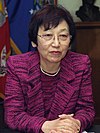 |
LDP | - |
| Finance minister | Sadakazu Tanigaki |  |
LDP | Ozato |
| Minister for Education, Culture, Sport, Science and Technology | Takeo Kawamura | 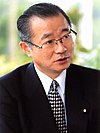 |
LDP | Hashimoto |
| Minister for Health, Labor and Social Affairs | Chikara Sakaguchi | 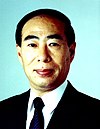 |
Kōmeitō | - |
| Minister for Agriculture, Forests and Fisheries | Yoshiyuki Kamei | 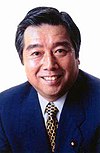 |
LDP | Yamasaki |
|
Minister of Economy, Trade and Industry responsible for the world exhibition |
Shōichi Nakagawa |  |
LDP | Kamei |
|
Minister of Land, Infrastructure and Transport responsible for the transfer of capital city functions and tourism |
Nobuteru Ishihara | 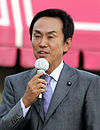 |
LDP | - |
|
Environment Minister responsible for global environmental issues |
Yuriko Koike |  |
LDP | Mori |
|
Chief Cabinet Secretary State Minister for Gender Equality |
Yasuo Fukuda until May 7, 2004 |
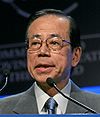 |
LDP | Mori |
|
Hiroyuki Hosoda from May 7, 2004 |
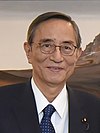 |
LDP | Mori | |
| Chair of the National Public Safety Commission Minister of State for Youth Education and Combating the Decline of Births, Food Safety |
Kiyoko Ono | 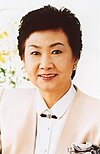 |
LDP | Kamei |
| Head of Defense | Shigeru Ishiba |  |
LDP | Hashimoto |
| Minister of State for Okinawa and Northern Territories Affairs , Data Protection, Science and Technology Policy, responsible for IT policy |
Toshimitsu Motegi |  |
LDP | Hashimoto |
| Minister of State for the Financial Sector, Economic and Tax Policy | Heizō Takenaka | 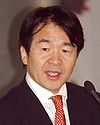 |
LDP | - |
| Minister of State for Deregulation, Industrial Revitalization, responsible for administrative reform, structural reform in special areas, regional reform |
Kazuyoshi Kaneko |  |
LDP | Horiuchi |
| Minister of State for Disaster Management Minister of State for National Emergency Legislation |
Kiichi Inoue |  |
NKP → LDP |
- → Nikai |
Note: The Prime Minister does not officially belong to any political group during his term of office.
resignation
- Cabinet Secretary Fukuda resigned as the only minister concerned because of a scandal involving missed payments into the state pension system, in which Prime Minister Koizumi and a number of other government and opposition politicians were also involved.
swell
Individual evidence
- ↑ Shūgiin: Minutes of Sessions 158. Kokkai, No. 1 November 29, appointment of a prime minister
- ^ Japan Minister Quits over Scandal. In: BBC News. May 7, 2004, accessed March 1, 2008 .